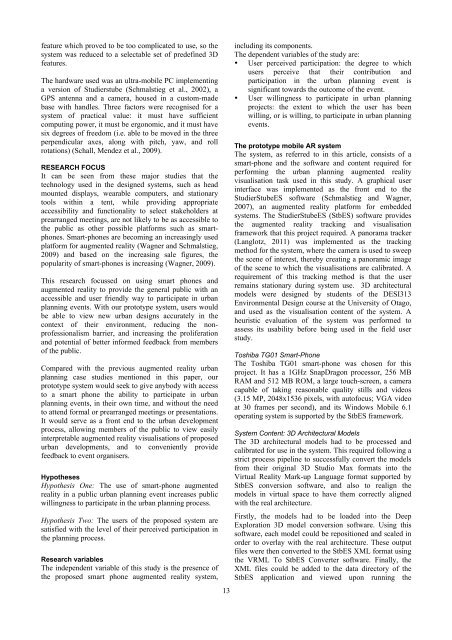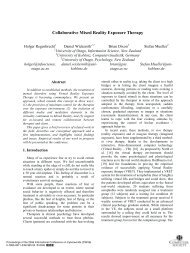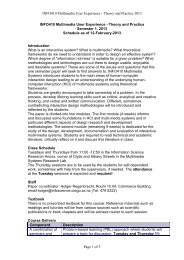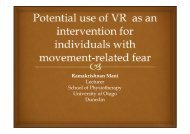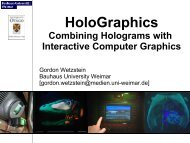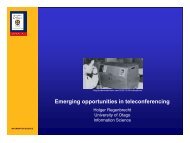Smart-phone augmented reality for public participation in urban ...
Smart-phone augmented reality for public participation in urban ...
Smart-phone augmented reality for public participation in urban ...
You also want an ePaper? Increase the reach of your titles
YUMPU automatically turns print PDFs into web optimized ePapers that Google loves.
feature which proved to be too complicated to use, so the<br />
system was reduced to a selectable set of predef<strong>in</strong>ed 3D<br />
features.<br />
The hardware used was an ultra-mobile PC implement<strong>in</strong>g<br />
a version of Studierstube (Schmalstieg et al., 2002), a<br />
GPS antenna and a camera, housed <strong>in</strong> a custom-made<br />
base with handles. Three factors were recognised <strong>for</strong> a<br />
system of practical value: it must have sufficient<br />
comput<strong>in</strong>g power, it must be ergonomic, and it must have<br />
six degrees of freedom (i.e. able to be moved <strong>in</strong> the three<br />
perpendicular axes, along with pitch, yaw, and roll<br />
rotations) (Schall, Mendez et al., 2009).<br />
RESEARCH FOCUS<br />
It can be seen from these major studies that the<br />
technology used <strong>in</strong> the designed systems, such as head<br />
mounted displays, wearable computers, and stationary<br />
tools with<strong>in</strong> a tent, while provid<strong>in</strong>g appropriate<br />
accessibility and functionality to select stakeholders at<br />
prearranged meet<strong>in</strong>gs, are not likely to be as accessible to<br />
the <strong>public</strong> as other possible plat<strong>for</strong>ms such as smart<strong>phone</strong>s.<br />
<strong>Smart</strong>-<strong>phone</strong>s are becom<strong>in</strong>g an <strong>in</strong>creas<strong>in</strong>gly used<br />
plat<strong>for</strong>m <strong>for</strong> <strong>augmented</strong> <strong>reality</strong> (Wagner and Schmalstieg,<br />
2009) and based on the <strong>in</strong>creas<strong>in</strong>g sale figures, the<br />
popularity of smart-<strong>phone</strong>s is <strong>in</strong>creas<strong>in</strong>g (Wagner, 2009).<br />
This research focussed on us<strong>in</strong>g smart <strong>phone</strong>s and<br />
<strong>augmented</strong> <strong>reality</strong> to provide the general <strong>public</strong> with an<br />
accessible and user friendly way to participate <strong>in</strong> <strong>urban</strong><br />
plann<strong>in</strong>g events. With our prototype system, users would<br />
be able to view new <strong>urban</strong> designs accurately <strong>in</strong> the<br />
context of their environment, reduc<strong>in</strong>g the nonprofessionalism<br />
barrier, and <strong>in</strong>creas<strong>in</strong>g the proliferation<br />
and potential of better <strong>in</strong><strong>for</strong>med feedback from members<br />
of the <strong>public</strong>.<br />
Compared with the previous <strong>augmented</strong> <strong>reality</strong> <strong>urban</strong><br />
plann<strong>in</strong>g case studies mentioned <strong>in</strong> this paper, our<br />
prototype system would seek to give anybody with access<br />
to a smart <strong>phone</strong> the ability to participate <strong>in</strong> <strong>urban</strong><br />
plann<strong>in</strong>g events, <strong>in</strong> their own time, and without the need<br />
to attend <strong>for</strong>mal or prearranged meet<strong>in</strong>gs or presentations.<br />
It would serve as a front end to the <strong>urban</strong> development<br />
process, allow<strong>in</strong>g members of the <strong>public</strong> to view easily<br />
<strong>in</strong>terpretable <strong>augmented</strong> <strong>reality</strong> visualisations of proposed<br />
<strong>urban</strong> developments, and to conveniently provide<br />
feedback to event organisers.<br />
Hypotheses<br />
Hypothesis One: The use of smart-<strong>phone</strong> <strong>augmented</strong><br />
<strong>reality</strong> <strong>in</strong> a <strong>public</strong> <strong>urban</strong> plann<strong>in</strong>g event <strong>in</strong>creases <strong>public</strong><br />
will<strong>in</strong>gness to participate <strong>in</strong> the <strong>urban</strong> plann<strong>in</strong>g process.<br />
Hypothesis Two: The users of the proposed system are<br />
satisfied with the level of their perceived <strong>participation</strong> <strong>in</strong><br />
the plann<strong>in</strong>g process.<br />
Research variables<br />
The <strong>in</strong>dependent variable of this study is the presence of<br />
the proposed smart <strong>phone</strong> <strong>augmented</strong> <strong>reality</strong> system,<br />
13<br />
<strong>in</strong>clud<strong>in</strong>g its components.<br />
The dependent variables of the study are:<br />
• User perceived <strong>participation</strong>: the degree to which<br />
users perceive that their contribution and<br />
<strong>participation</strong> <strong>in</strong> the <strong>urban</strong> plann<strong>in</strong>g event is<br />
significant towards the outcome of the event.<br />
• User will<strong>in</strong>gness to participate <strong>in</strong> <strong>urban</strong> plann<strong>in</strong>g<br />
projects: the extent to which the user has been<br />
will<strong>in</strong>g, or is will<strong>in</strong>g, to participate <strong>in</strong> <strong>urban</strong> plann<strong>in</strong>g<br />
events.<br />
The prototype mobile AR system<br />
The system, as referred to <strong>in</strong> this article, consists of a<br />
smart-<strong>phone</strong> and the software and content required <strong>for</strong><br />
per<strong>for</strong>m<strong>in</strong>g the <strong>urban</strong> plann<strong>in</strong>g <strong>augmented</strong> <strong>reality</strong><br />
visualisation task used <strong>in</strong> this study. A graphical user<br />
<strong>in</strong>terface was implemented as the front end to the<br />
StudierStubeES software (Schmalstieg and Wagner,<br />
2007), an <strong>augmented</strong> <strong>reality</strong> plat<strong>for</strong>m <strong>for</strong> embedded<br />
systems. The StudierStubeES (StbES) software provides<br />
the <strong>augmented</strong> <strong>reality</strong> track<strong>in</strong>g and visualisation<br />
framework that this project required. A panorama tracker<br />
(Langlotz, 2011) was implemented as the track<strong>in</strong>g<br />
method <strong>for</strong> the system, where the camera is used to sweep<br />
the scene of <strong>in</strong>terest, thereby creat<strong>in</strong>g a panoramic image<br />
of the scene to which the visualisations are calibrated. A<br />
requirement of this track<strong>in</strong>g method is that the user<br />
rema<strong>in</strong>s stationary dur<strong>in</strong>g system use. 3D architectural<br />
models were designed by students of the DESI313<br />
Environmental Design course at the University of Otago,<br />
and used as the visualisation content of the system. A<br />
heuristic evaluation of the system was per<strong>for</strong>med to<br />
assess its usability be<strong>for</strong>e be<strong>in</strong>g used <strong>in</strong> the field user<br />
study.<br />
Toshiba TG01 <strong>Smart</strong>-Phone<br />
The Toshiba TG01 smart-<strong>phone</strong> was chosen <strong>for</strong> this<br />
project. It has a 1GHz SnapDragon processor, 256 MB<br />
RAM and 512 MB ROM, a large touch-screen, a camera<br />
capable of tak<strong>in</strong>g reasonable quality stills and videos<br />
(3.15 MP, 2048x1536 pixels, with autofocus; VGA video<br />
at 30 frames per second), and its W<strong>in</strong>dows Mobile 6.1<br />
operat<strong>in</strong>g system is supported by the StbES framework.<br />
System Content: 3D Architectural Models<br />
The 3D architectural models had to be processed and<br />
calibrated <strong>for</strong> use <strong>in</strong> the system. This required follow<strong>in</strong>g a<br />
strict process pipel<strong>in</strong>e to successfully convert the models<br />
from their orig<strong>in</strong>al 3D Studio Max <strong>for</strong>mats <strong>in</strong>to the<br />
Virtual Reality Mark-up Language <strong>for</strong>mat supported by<br />
StbES conversion software, and also to realign the<br />
models <strong>in</strong> virtual space to have them correctly aligned<br />
with the real architecture.<br />
Firstly, the models had to be loaded <strong>in</strong>to the Deep<br />
Exploration 3D model conversion software. Us<strong>in</strong>g this<br />
software, each model could be repositioned and scaled <strong>in</strong><br />
order to overlay with the real architecture. These output<br />
files were then converted to the StbES XML <strong>for</strong>mat us<strong>in</strong>g<br />
the VRML To StbES Converter software. F<strong>in</strong>ally, the<br />
XML files could be added to the data directory of the<br />
StbES application and viewed upon runn<strong>in</strong>g the


